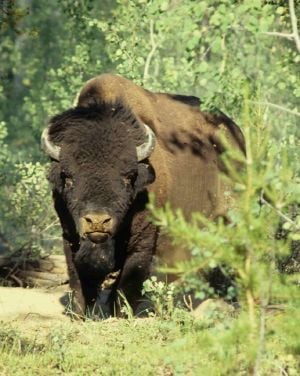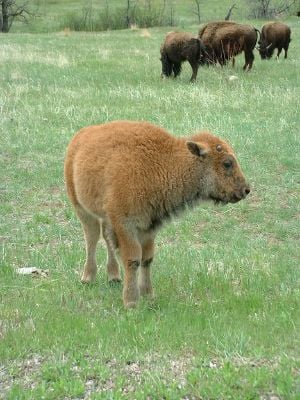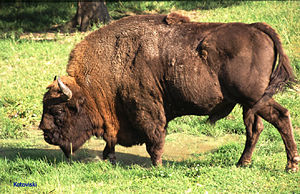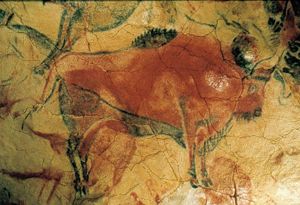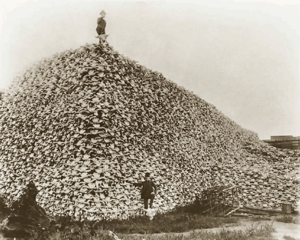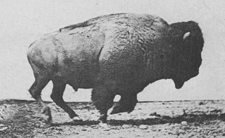Difference between revisions of "Bison" - New World Encyclopedia
| Line 37: | Line 37: | ||
==The bison's place in nature== | ==The bison's place in nature== | ||
[[Image:Bison1-Custer State Park-SD.jpg|thumb|left|Juvenile American bison in late May in Custer State Park, South Dakota]] | [[Image:Bison1-Custer State Park-SD.jpg|thumb|left|Juvenile American bison in late May in Custer State Park, South Dakota]] | ||
| − | Bison are strictly herbivores. American bison, which live mainly in grassslands, are grazers while European bison, living mainly in forests, are browsers. American bison migrate over the grassland to reach better conditions. In the past herds of millions traveled hundreds of miles seasonally to take advantage of different growing conditions. This | + | Bison are strictly herbivores. American bison, which live mainly in grassslands, are grazers while European bison, living mainly in forests, are browsers. American bison migrate over the grassland to reach better conditions. In the past herds of millions traveled hundreds of miles seasonally to take advantage of different growing conditions. This gives the [[grass]] a chance to recover and regrow. The bisons' droppings and urine fertilize the soil, returning needed [[nitrogen]] (Lott 2002). |
[[Image:Wood-Buffalo-NP Waldbison 3 98-07-02.jpg|thumb|Wood bison rolling in dust]] | [[Image:Wood-Buffalo-NP Waldbison 3 98-07-02.jpg|thumb|Wood bison rolling in dust]] | ||
Bison are subject to various parasites, among them the Winter tick, ''Dermacentor albipictus'', a single one of which can reduce a calf's growth by 1.5 lbs (.7 kg) due to the blood it takes. Bison roll in dirt in order to remove ticks and other parasites. This also helps them to keep cool in hot weather (Lott 2002). | Bison are subject to various parasites, among them the Winter tick, ''Dermacentor albipictus'', a single one of which can reduce a calf's growth by 1.5 lbs (.7 kg) due to the blood it takes. Bison roll in dirt in order to remove ticks and other parasites. This also helps them to keep cool in hot weather (Lott 2002). | ||
| Line 58: | Line 58: | ||
The American bison has also made a comeback with about 20,000 living in the wild in parks and preserves, including Yellowstone National Park, and about 500,000 living on ranches and tribal lands where they are managed although not domesticated. Bison ranching continues to expand yearly while bison meat becomes more popular, partly because of its lower [[fat]] and higher [[iron]] and [[vitamin]] B12 content compared to beef (NBA 2006). | The American bison has also made a comeback with about 20,000 living in the wild in parks and preserves, including Yellowstone National Park, and about 500,000 living on ranches and tribal lands where they are managed although not domesticated. Bison ranching continues to expand yearly while bison meat becomes more popular, partly because of its lower [[fat]] and higher [[iron]] and [[vitamin]] B12 content compared to beef (NBA 2006). | ||
| − | For Americans the bison is an important part of history, a symbol of national identity, and a favorite subject of | + | For Americans the bison is an important part of history, a symbol of national identity, and a favorite subject of artists. Many American towns, sports teams, and other organizations use the bison as a symbol, most often under the name "Buffalo". For many Native Americans the bison holds an even greater importance. Fred DuBray of the Cheyenne River Sioux said (IBC 2006): |
:"We recognize the bison is a symbol of our strength and unity, and that as we bring our herds back to health, we will also bring our people back to health." | :"We recognize the bison is a symbol of our strength and unity, and that as we bring our herds back to health, we will also bring our people back to health." | ||
Revision as of 22:06, 12 November 2006
| Bison | ||||||||||||||
|---|---|---|---|---|---|---|---|---|---|---|---|---|---|---|
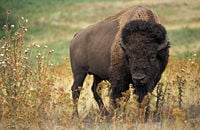 {{{caption}}} | ||||||||||||||
| Scientific classification | ||||||||||||||
| ||||||||||||||
| Species | ||||||||||||||
|
B. bison |
Bison are members of the genus Bison of the Bovid family of the even-toed ungulates, or hoofed mammals. There are three types of living bison:
- The American bison (Bison bison bison), the most famous bison, formerly one of the most common large animals in North America
- The Wood bison (Bison bison athabascae), considered to be a subspecies of the American bison
- The European bison or Wisent (Bison bonasus)
There were also several other species of bison which became extinct within the last 10,000 years.
Bison are often called "buffalo" in North America. They are very closely related to cattle, yaks, true buffalo, and other members of the subfamily Bovinae, or bovines.
Bison physiology and behavior
Bison are among the largest hoofed mammals, standing 1.5 to 2 meters (5 to 6.5 feet) at the shoulder and weighing 350 to 1000 kg (800 to 2,200 lbs). Males average larger than females. The head and forequarters are especially massive with a large hump on the shoulders. Both sexes have horns with the male's being somewhat larger. (Nowak 1983).
Bison mature in about two years and have an average life span of about twenty years. A female bison can have a calf every year with mating taking place in summer and birth in spring when conditions are best for the young animal. Male bison fight with each other over the right to mate with females. The male bison's greater size, larger horns, and thicker covering of hair on the head and front of the body benefit them in these struggles. In many cases the smaller, younger, or less confident male will back down and no actual fight will take place. (Lott 2002).
The bison's place in nature
Bison are strictly herbivores. American bison, which live mainly in grassslands, are grazers while European bison, living mainly in forests, are browsers. American bison migrate over the grassland to reach better conditions. In the past herds of millions traveled hundreds of miles seasonally to take advantage of different growing conditions. This gives the grass a chance to recover and regrow. The bisons' droppings and urine fertilize the soil, returning needed nitrogen (Lott 2002).
Bison are subject to various parasites, among them the Winter tick, Dermacentor albipictus, a single one of which can reduce a calf's growth by 1.5 lbs (.7 kg) due to the blood it takes. Bison roll in dirt in order to remove ticks and other parasites. This also helps them to keep cool in hot weather (Lott 2002).
One animal that has a mutually beneficial symbiotic relationship with the American bison is the Black-tailed prairie dog, Cynomys ludovicianus, a small rodent. Prairie dogs eat the same grass as the bison and live in large groups in underground tunnels called "towns". Bison are attracted to prairie dog towns by the large mounds of dirt removed from the tunnels which the bison use to roll in. The bison benefit the prairie dogs by eating the tall grass and fertilizing the soil, both of which promote the growth of the more nutritious new short grass (Lott 2002).
Because of their large size and strength bison have few predators. In both America and Europe wolves, Canis lupus, are (or were) the most serious predator of bison (besides humans). The wolves' habit of hunting in groups enables them to prey on animals much larger than themselves. But most often it is the calves that fall victim to wolves. It has been suggested that the bison's tendency to run away from predators rather than standing and fighting like many other bovines, including probably the extinct bison species, has given them a better chance against wolves and later human hunters. The Brown bear (Ursus arctos), called the Grizzly bear in North America, also eats bison but is too slow to catch healthy, alert adult bison so mainly eats those that have died from cold or disease (Lott 2002).
Bison and humans
Bison were an important prey for human hunters from prehistoric times. The National Bison Association lists over 150 traditional Native American uses for bison products, besides food (NBA 2006). After the introduction of the horse to North America in the 1500s made hunting bison easier bison became even more important to some Native American tribes living on the Great Plains. It is estimated that there were about 30,000,000 bison in North America at this time (Lott 2002).
As white Americans moved into Native American lands the bison were killed off. Some of the reasons for this were to free land for agriculture and cattle ranching, to sell the hides of the bison, as a tactic to deprive hostile tribes of their main food supply, and for what was considered sport. The worst of the killing took place in the 1870s and the early 1880s. By 1890 there were fewer than 1,000 bison in North America (Nowak 1983).
The European bison was also hunted almost to extinction by 1927 with the only survivors living in zoos. Since that time it has been reintroduced to the wild and there are about 3,000 living today.
The Wood bison had been reduced to about 250 animals by 1900 but has now recovered to about 9,000, living mainly in northwest Canada.
The American bison has also made a comeback with about 20,000 living in the wild in parks and preserves, including Yellowstone National Park, and about 500,000 living on ranches and tribal lands where they are managed although not domesticated. Bison ranching continues to expand yearly while bison meat becomes more popular, partly because of its lower fat and higher iron and vitamin B12 content compared to beef (NBA 2006).
For Americans the bison is an important part of history, a symbol of national identity, and a favorite subject of artists. Many American towns, sports teams, and other organizations use the bison as a symbol, most often under the name "Buffalo". For many Native Americans the bison holds an even greater importance. Fred DuBray of the Cheyenne River Sioux said (IBC 2006):
- "We recognize the bison is a symbol of our strength and unity, and that as we bring our herds back to health, we will also bring our people back to health."
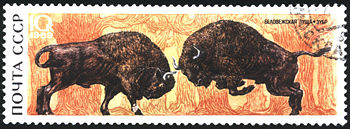
ReferencesISBN links support NWE through referral fees
- Intertribal Bison Cooperative (IBC). 2006. Website[1]
- Lott, D.F. 2002. American Bison. Berkeley, California : University of California Press
- National Bison Association (NBA). 2006 Website[2]
- Nowak, R.M. and Paradiso, J.L. 1983. Walker's Mammals of the World. Baltimore, Maryland : The Johns Hopkins University Press
- Voelker, W. 1986. The Natural History of Living Mammals. Medford, New Jersey : Plexus Publishing, Inc.
Credits
New World Encyclopedia writers and editors rewrote and completed the Wikipedia article in accordance with New World Encyclopedia standards. This article abides by terms of the Creative Commons CC-by-sa 3.0 License (CC-by-sa), which may be used and disseminated with proper attribution. Credit is due under the terms of this license that can reference both the New World Encyclopedia contributors and the selfless volunteer contributors of the Wikimedia Foundation. To cite this article click here for a list of acceptable citing formats.The history of earlier contributions by wikipedians is accessible to researchers here:
The history of this article since it was imported to New World Encyclopedia:
Note: Some restrictions may apply to use of individual images which are separately licensed.
